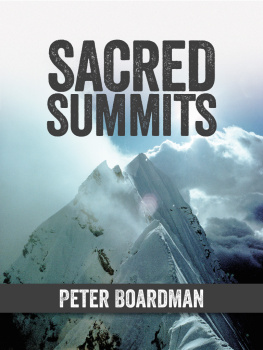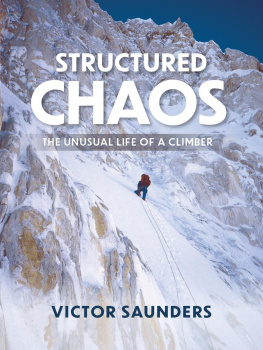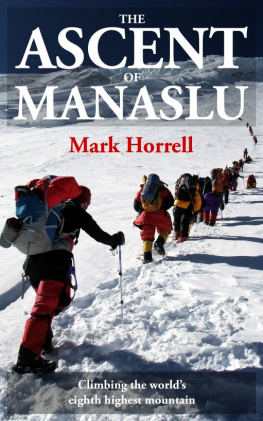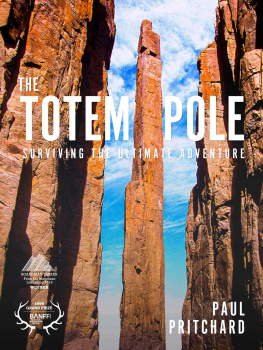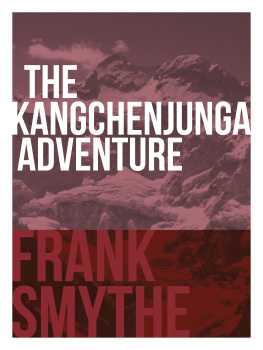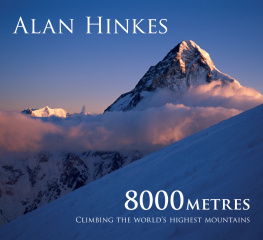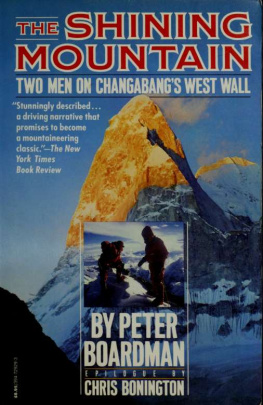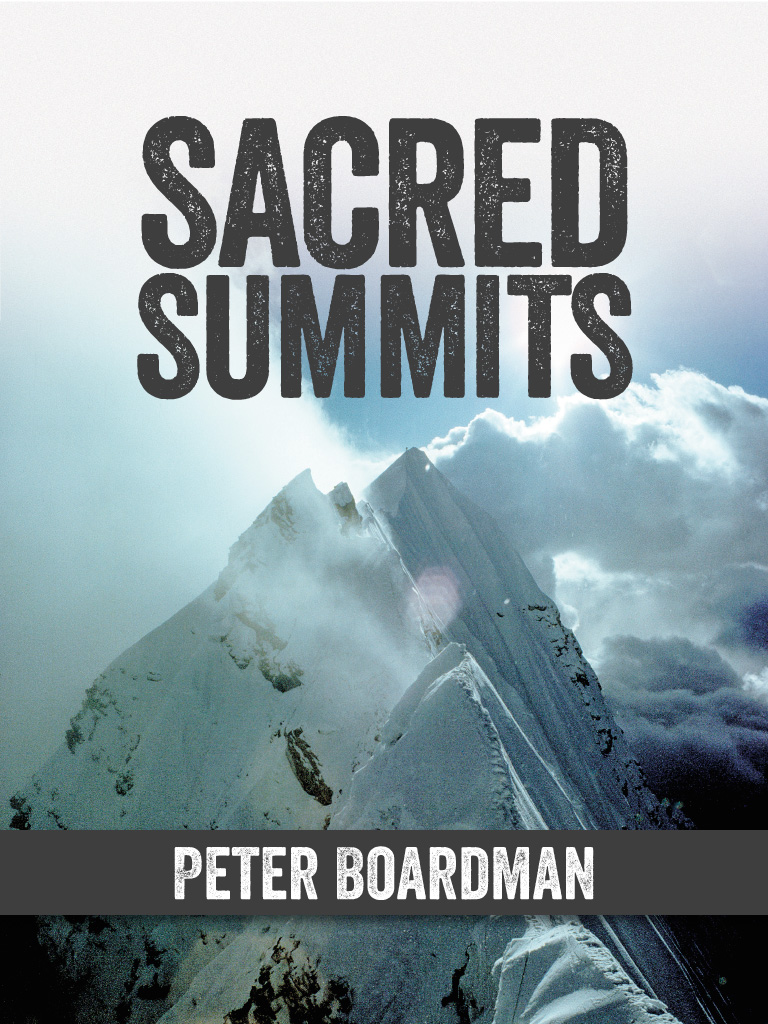Foreword
A Great Partnership
Chris Bonington
It was 15 May 1982 at Advance Base on the north side of Everest. Its a bleak place. The tents were pitched on a moraine the debris of an expedition in its end stage scattered over the rocks. Pete and Joe fussed around with final preparations, packing their rucksacks and putting in a few last minute luxuries. Then suddenly they were ready, crampons on, rope tied, set to go. I think we were all trying to underplay the moment.
See you in a few days.
Well call you tonight at six.
They set off, plodding up the ice slope beyond the camp through flurries of wind-driven snow. Two days later, in the fading light of a cold dusk, Adrian Gordon and I were watching their progress high on the North East Ridge through our telescope. Two tiny figures on the crest outlined against the golden sky of the late evening, moving painfully slowly, one at a time. Was it because of the difficulty or the extreme altitude, for they must have been at approximately, 27,000 feet (8230 metres)?
Gradually they disappeared from sight behind the jagged tooth of the Second Pinnacle. They never appeared again, although Peters body was discovered by members of a Russian/Japanese expedition in the spring of 1992, just beyond where we had last seen them. It was as if he had lain down in the snow, gone to sleep and never woken. We shall probably never know just what happened in those days around 17 May, but in that final push to complete the unclimbed section of the North East Ridge of Everest, we lost two very special friends and a unique climbing partnership whose breadth of talent went far beyond mountaineering. Their ability as writers is amply demonstrated in their books.
My initial encounter with Peter was in 1975 when I was recruiting for the expedition to the South West Face of Everest. I was impressed by his maturity at the age of 23, yet this was combined with a real sense of fun and a touch of the little boy lost manner, which he could use with devastating effect to get his own way. In addition, he was both physically and intellectually talented. He was a very strong natural climber and behind that diffident, easy-going manner had a personal drive and unwavering sense of purpose. He also had a love of the mountains and the ability to express it in writing. He was the youngest member of the Everest team and went to the top with our Sherpa sirdar, Pertemba, making the second complete ascent of the previously unclimbed South West Face.
As National Officer of the BMC, he proved a diplomat and a good committee man. After Dougal Hastons death in an avalanche in Switzerland, he took over Dougals International School of Mountaineering in Leysin. He went on to climb the sheer West Face of Changabang with Joe Tasker, which was the start of their climbing partnership. It was a remarkable achievement, in stark contrast to the huge expedition we had had on Everest. On Changabang there had just been Pete and Joe. They had planned to climb it alpine-style, bivouacking in hammocks on the face, but it had been too cold, too great a strain at altitude, and they had resorted to siege tactics. Yet even this demanded huge reserves of determination and endurance. The climb, in 1976, was probably technically the hardest that had been completed in the Himalaya at that time, and Pete describes their struggles in his first book, The Shining Mountain, which won the John Llewelyn Rhys Prize in 1979.
Pete packed a wealth of varied climbing next few years. In 1978 both he and Joe joined me on K2. We attempted the West Ridge but abandoned it comparatively low down after Nick Estcourt was killed in an avalanche. In early 1979 Pete reached the summit of the Carstensz Pyramid, in New Guinea, with his future wife, Hilary, just before going to Kangchenjunga (the worlds third highest mountain) with Joe, and Doug Scott and Georges Bettembourg That same autumn he led a small and comparatively another team on a very bold ascent of the South Summit of Gauri Sankar.
The following year he returned to K2 with Joe, Doug and Dick Renshaw. They first attempted the West Ridge, the route that we had tried in 1978, but abandoned this a couple of hundred metres higher than our previous high point. Doug Scott returned home but the other three made two very determined assaults on the Abruzzi Spur, getting to within 600 metres of the summit before being avalanched off on their first effort, and beaten by bad weather on a subsequent foray. Two years later Pete and Joe, with Alan Rouse, joined me on Kongur, at the time the third-highest unclimbed peak in the world. It proved a long drawn out, exacting expedition.
Joe Tasker was very different to Peter, both in appearance and personality. This perhaps contributed to the strength of their partnership. While Pete appeared to be easy going and relaxed, Joe was very much more intense, even abrasive. He came from a large Roman Catholic family on Teesside and went to a seminary at the age of 13 to train for the priesthood, but at the age of 18 he had begun to have serious doubts about his vocation and went to study sociology at Manchester University. Inevitably, his period at the seminary left its mark. Joe had a built-in reserve that was difficult to penetrate but, at the same time, he had an analytical, questioning mind. He rarely accepted an easy answer and kept going at a point until satisfied that it had been answered in full.
In their climbing relationship had a jokey yet competitive tension in which neither of them being wished to be the first to admit weakness or to suggest retreat. It was a trait that not only contributed to their drive but could also cause them to push themselves to the limit.
Joe had served an impressive alpine apprenticeship in the early seventies when, with Dick Renshaw, they worked through some of the hardest climbs in the Alps, both in summer and winter. These included the first British ascent (one of the very few ever ascents) of the formidable and very remote East Face of the Grandes Jorasses. In addition they made the first British winter ascent of the North Wall of the Eiger. With Renshaw he went on to climb, in alpine-style, the South Ridge of Dunagiri. It was a bold ascent by any standards, outstandingly so for a first Himalayan expedition. Dick was badly frostbitten and this led to Joe inviting Pete to join him on Changabang the start of their climbing partnership.
On our K2 expedition in 1978, I had barely had the chance to get to know Joe well, but I remember bring exasperated by his constant questioning of decisions, particularly while we were organising the expedition. At the time I felt he was a real barrack-room lawyer but, on reflection, realised that he probably found my approach equally exasperating. We climbed together throughout the 1981 Kongur expedition and I came to know him much better, to find that under that tough outer shell there was a very warm heart. Prior to that, in the winter of 1980-81, he went to Everest with a strong British expedition to attempt the West Ridge. He told the story in his first book, Everest the Cruel Way.
Our 1982 expedition to Everests North East Ridge was a huge challenge but our team was one of the happiest and most closely united of any trip I have been on. There were only six in the party and just four of us, Joe, Pete, Dick Renshaw and I, were planning to tackle the route. Charlie Clarke and Adrian Gordon were there in support going no further than Advance Base. However, there was a sense of shared values, affection and respect, that grew stronger through adversity, as we came to realise just how vast was the undertaking our small team was committed to.

